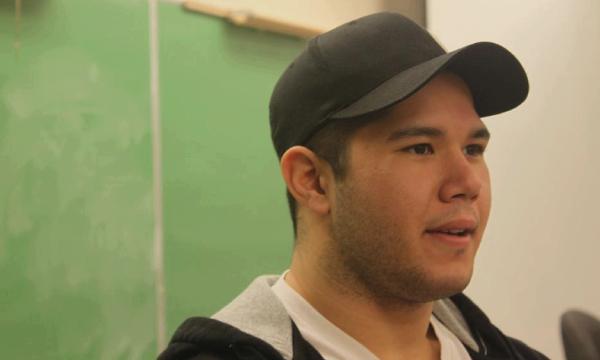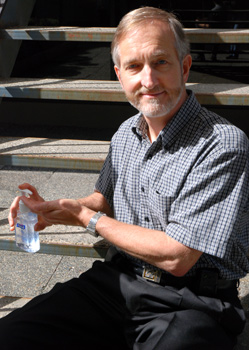Kwantlen, KSA distribute on-campus H1N1 vaccines
January 20, 2010 by Jacob Zinn · Leave a Comment

Brandon Tuason, a history and arts student, thinks it's important for students to get the H1N1 vaccine and keep from spreading the virus through the student population. (Jacob Zinn photo)
In a joint effort, Kwantlen Polytechnic University and the KSA are providing free H1N1 vaccinations this week to students and employees at all four campuses.
Since Tuesday, more than a hundred on-vaccinations have been administered at the Surrey and Richmond campuses.
Lesley England, a registered nurse with ProGroup, said the turnout for vaccinations has been quite good. On Monday, she expected to give 70 vaccinations at the Surrey campus. She gave 88.
By 12:30 p.m. on Tuesday, she’d vaccinated another 45 students on the Richmond campus.
“A lot of people who are getting the H1N1 [vaccine] have never had flu vaccines before,” said England, who is expecting a third wave of the H1N1 influenza virus to arrive in February.
Nurses will visit the Langley campus Thursday and the Cloverdale campus Friday in hopes of immunizing procrastinating students.
When the H1N1 vaccine was being developed last fall, the KSA hoped to include it in the health and dental plan. However, the government purchased enough of the vaccine for all Canadians and offered it for free at clinics.
“It’s readily available now. You can go to your doctor and get the shot,” said Eddie Lee, coordinator of the Student Health Improvement Program.
“However, we know that there are students and employees who probably still won’t go–it’s a lack of convenience for them, so we decided to bring it on campus.”
It’s that inconvenience that has kept Nick Mostar, 22, from finding time for the vaccination.
“I’ve been doing schoolwork and haven’t really had the time to go to a clinic or anything,” said Mostar who is in the engineering program.
Not all students have waited quite as long. Brandon Tuason, 21, got the H1N1 vaccine several months ago. He was at risk of getting the virus because, at birth, he was diagnosed with severe asthma, making him more prone to infection.
“We’re in an environment where everybody’s kinda in close quarters,” said Tuason. “Infections can spread really quickly. I think the school is taking a good initiative in preventing a lot of that by giving the immunization away.”
Fraser Health predicts and prepares for worst-case flu scenario
January 12, 2010 by Sarah Jackson · Leave a Comment

Dr. Roland Guasparini, chief medical health officer for Fraser Health, models the use of hand sanitizer as protection against H1N1 contraction. (Sarah Jackson photo)
After months of monitoring the southern hemisphere’s H1N1 cases, Fraser Health has determined 40 per cent of the world’s population will catch H1N1 before next April.
The number is twice the yearly 20 per cent seasonal flue infection rate, according to Dr. Roland Guasparini, Fraser Health’s chief medical health officer.
“The vast majority are going to have a mild, self-limiting illness,” Guasparini said. “[But] the flu’s not really mild. You will feel like you get hit with a truck.”
Fraser Health based its estimate on the number of cases that have been reported in the southern hemisphere. As winter and the flu season comes to an end there, the infection rate offers a glimpse into what residents of the northern hemisphere should expect.
Guasparini said Fraser Health has been planning for a severe pandemic for many years, expecting it to surface at any time. The summer arrival of the H1N1 flu suggests that the virus will peak early, over the next eight to 12 weeks, and taper off by December.
The health unit has spent most of its time planning for a worst-case scenario including 200 intensive-care patients, more than Fraser Health facilities can currently house.
To prepare, it has planned alternative treatment sites, purchased additional ventilators and decided how to staff additional health care locations.
“But we’re not going to see that worst-case scenario,” said Guasparini. “We’re expecting, based on the southern hemisphere, that we’ll be able to manage the hospital cases as usual.”
H1N1 is a contagious disease, he explained, so “the attack rate will be the same regardless of the severity of the symptoms.†A mild disease could, however, allow H1N1 to spread more widely than expected if infected people don’t remain home until they recover.
Current concern is for the elderly, children, pregnant women and those with chronic respiratory and cardiac conditions. Those who fall into these categories are at a high risk for severe illness until they receive the H1N1 vaccination, which will not be available until November.
“We’re hoping . . . we just have a seasonal flu year, but the nice thing about all the media attention is that it’s just brought attention to safety conditions,†said Guasparini.
The message about hand-washing, coughing into a shirt sleeve and staying home when sick “has hit home in a big way.â€
He said the media is doing a great job of accurately presenting H1N1 facts. Public-health workers are dealing with the additional strain of responding to patients’ concerns, but the attention devoted to understanding the threats and safety procedures is a new and welcome phenomena.
During previous pandemics, the methods of communication were far more limited.
Guasparini said the international attention and response is a testimony to the system health officials have for monitoring and responding to infectious diseases.
“People are not scared, they just kinda focused their attention.â€
Don MacLachlan, former managing editor at the Province and former director of public relations for Fraser Health, agreed that media has “been doing a very responsible job.â€
MacLachlan said the public perceives H1N1 as a problem, and its status as a pandemic means it is, so the media is rightly informing people about it.
A number of rumours have cropped up since H1N1 first appeared, leaving some people hesitant to trust media coverage. Bulletins have been issued debunking beliefs that H1N1 can be contracted by eating pork, that entire villages in Asia were being wiped out and that the coverage is only hype. But the myths aren’t from the mainstream media, said MacLachlan.
“People aren’t reading or listening to traditional media news. They get news from Facebook, Twitter or MySpace and they treat that as the definitive truth.â€
The media attention has pushed some towards fear or skepticism about the reality of the threat. MacLachlan attributed any “exaggerated state of concern or panic†to individuals who are receiving the media’s messages. He added that “people are hearing and reacting responsibly to responsible messages.â€


